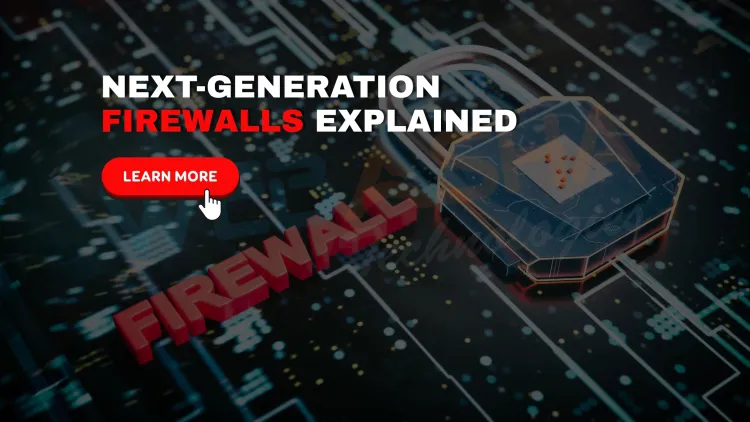What Are Next-Generation Firewalls and How Do They Work to Protect Modern Networks?
Discover how next-generation firewalls (NGFWs) protect networks using deep packet inspection, app control, and threat prevention in modern cybersecurity.

Table of Contents
- What Is a Next-Generation Firewall (NGFW)?
- How Do Next-Generation Firewalls Work?
- Top Features of Next-Generation Firewalls
- Top Vendors in NGFW Market (2025)
- Use Cases of NGFWs in Real Environments
- Benefits of Using NGFWs
- Challenges and Considerations
- Next-Gen Firewall vs UTM vs Traditional Firewall
- Deployment Models for NGFWs
- Best Practices for Implementing NGFWs
- Conclusion
- Frequently Asked Questions (FAQs)
Next-Generation Firewalls (NGFWs) are advanced security solutions that combine traditional firewall capabilities with modern features like intrusion prevention, application awareness, deep packet inspection, and encrypted traffic scanning. These firewalls are crucial in today’s complex cyber threat landscape, offering visibility, control, and real-time protection across cloud, on-premises, and hybrid environments. Unlike traditional firewalls, NGFWs identify threats based on behavior, context, and application signatures, making them essential for modern organizations seeking proactive and intelligent network defense.
What Is a Next-Generation Firewall (NGFW)?
A Next-Generation Firewall (NGFW) is a security device or service that not only monitors and controls incoming/outgoing traffic based on predefined rules (like traditional firewalls) but also integrates advanced threat detection and behavior-based analytics.
Key Differences from Traditional Firewalls:
-
Traditional firewalls block traffic based on IP, port, and protocol.
-
NGFWs analyze packet contents, user identity, app usage, and threat intelligence in real-time.
NGFWs are designed to prevent advanced persistent threats (APTs), malware, ransomware, and zero-day exploits using AI-driven analytics and cloud-delivered intelligence.
How Do Next-Generation Firewalls Work?
NGFWs function by inspecting network traffic deeply and intelligently. They use a combination of:
-
Application Layer Filtering: Understands and controls traffic based on application, not just port.
-
Deep Packet Inspection (DPI): Examines full packet content to detect hidden threats.
-
Intrusion Prevention System (IPS): Blocks known attack signatures and suspicious behaviors.
-
SSL/TLS Decryption: Scans encrypted traffic for malware or data exfiltration.
-
User Identity Integration: Applies security policies based on user roles, not just IPs.
NGFWs use machine learning models and threat intelligence feeds to detect anomalies in real-time, adapting as threats evolve.
Top Features of Next-Generation Firewalls
| Feature | Description |
|---|---|
| Application Awareness | Identifies and controls app usage (e.g., Zoom vs. Skype). |
| Deep Packet Inspection | Analyzes packet content to detect malicious payloads. |
| Intrusion Prevention (IPS) | Detects and blocks known attack signatures. |
| SSL/TLS Traffic Inspection | Decrypts and inspects encrypted traffic. |
| User Identity Integration | Maps user behavior and applies identity-aware policies. |
| Threat Intelligence | Syncs with cloud-based feeds to stay current with global threats. |
| Sandboxing | Analyzes suspicious files in isolated environments before allowing access. |
| Zero Trust Enforcement | Assumes all users/apps are threats until verified. |
Top Vendors in NGFW Market (2025)
-
Palo Alto Networks – AI-powered NGFWs with strong Zero Trust architecture.
-
Fortinet – FortiGate offers high-performance unified threat protection.
-
Cisco – Secure Firewall with integration into their larger security ecosystem.
-
Check Point – Deep threat detection with contextual firewall rules.
-
Sophos XG Firewall – Known for synchronized security across endpoints and firewalls.
Use Cases of NGFWs in Real Environments
-
Enterprise Networks: Securing remote users, branches, and cloud connections.
-
Cloud Workloads: Protecting virtual machines, containers, and cloud apps.
-
Healthcare: HIPAA-compliant protection for patient data across networks.
-
Finance: Preventing fraud and unauthorized access to financial systems.
-
Education: Filtering applications and content while securing research data.
Benefits of Using NGFWs
-
Stops advanced cyberattacks before they spread.
-
Increases visibility into app, user, and device behavior.
-
Reduces reliance on multiple security products.
-
Enables consistent policy enforcement across hybrid environments.
-
Supports compliance (e.g., GDPR, HIPAA, PCI-DSS).
Challenges and Considerations
| Challenge | Explanation |
|---|---|
| Performance Overhead | DPI and SSL inspection may slow down traffic. |
| Complexity | Requires skilled professionals to configure and monitor. |
| Cost | Higher initial investment than legacy firewalls. |
| False Positives | Over-aggressive rules may block legitimate traffic. |
Next-Gen Firewall vs UTM vs Traditional Firewall
| Category | Traditional Firewall | UTM (Unified Threat Management) | NGFW |
|---|---|---|---|
| Packet Filtering | ✅ | ✅ | ✅ |
| Application Control | ❌ | Limited | ✅ |
| DPI & SSL Inspection | ❌ | ✅ (basic) | ✅ (advanced) |
| Threat Intelligence | ❌ | ❌ | ✅ |
| AI & Machine Learning | ❌ | ❌ | ✅ |
| Zero Trust Support | ❌ | ❌ | ✅ |
Deployment Models for NGFWs
-
Hardware Appliance – On-premise firewall devices for large enterprises.
-
Virtual Firewall – Runs as a virtual machine for cloud/hybrid deployments.
-
Cloud-Native NGFWs – Integrated into public clouds like AWS, Azure, or GCP.
-
Firewall as a Service (FWaaS) – Delivered fully from the cloud, scalable and managed.
Best Practices for Implementing NGFWs
-
Perform a risk assessment before deployment.
-
Align firewall rules with Zero Trust principles.
-
Regularly update firmware and threat intelligence feeds.
-
Enable encrypted traffic inspection with user consent policies.
-
Monitor logs and alerts through centralized dashboards.
Conclusion
Next-Generation Firewalls represent the evolution of network security, capable of adapting to modern threats using behavioral analytics, AI, and cloud integration. They are essential for organizations seeking proactive defense, especially in hybrid or remote-first environments. Whether you’re protecting endpoints, cloud apps, or core networks, an NGFW provides real-time visibility, control, and prevention, making it a cornerstone of your cybersecurity strategy in 2025 and beyond.
FAQs
What is a Next-Generation Firewall?
It’s a firewall that includes traditional filtering along with advanced features like application control and threat detection.
How is an NGFW different from a traditional firewall?
NGFWs inspect traffic more deeply, provide app awareness, and integrate threat intelligence, unlike traditional firewalls.
What threats can NGFWs prevent?
NGFWs block malware, ransomware, zero-day exploits, phishing attacks, and unauthorized access.
Can NGFWs inspect encrypted traffic?
Yes, most NGFWs support SSL/TLS decryption to scan encrypted packets.
What is deep packet inspection (DPI)?
DPI examines full packet content (not just headers) to detect malicious data or patterns.
Do NGFWs support remote work security?
Yes, they help secure VPNs, cloud apps, and endpoint access in hybrid environments.
What is application-level filtering in NGFWs?
It identifies specific apps like Zoom or Facebook and allows/block them based on policies.
Are NGFWs cloud compatible?
Yes, most modern NGFWs offer virtual or cloud-native versions.
Can NGFWs replace antivirus software?
No, they complement endpoint protection but don’t replace it.
Which companies lead in NGFW technology?
Palo Alto Networks, Fortinet, Cisco, Check Point, and Sophos are top vendors.
Is NGFW suitable for small businesses?
Yes, many vendors offer scaled-down NGFWs for SMEs with budget-friendly pricing.
What is a firewall as a service (FWaaS)?
A cloud-delivered NGFW that scales on demand and is managed externally.
Do NGFWs use AI or machine learning?
Yes, to detect new threat patterns and automate responses.
Can NGFWs be centrally managed?
Yes, they often include management consoles for unified control.
What is intrusion prevention (IPS) in NGFWs?
IPS detects and blocks known attack patterns using signatures and heuristics.
How often should firewall rules be updated?
Regularly—weekly or monthly—to reflect new risks and business needs.
Are next-gen firewalls expensive?
They can be, but cloud-based or virtual NGFWs are more cost-effective.
What are sandboxing features in NGFWs?
They isolate suspicious files to observe behavior before allowing them on the network.
Do NGFWs help with compliance?
Yes, they help meet requirements for HIPAA, PCI-DSS, GDPR, etc.
What is zero trust and how does NGFW support it?
Zero trust assumes no user or device is safe by default. NGFWs enforce strict identity and traffic controls.
Can NGFWs integrate with SIEM tools?
Yes, for centralized alerting, correlation, and automated response.
How do NGFWs support mobile device security?
They filter traffic from mobile endpoints and can enforce app-based rules.
Are virtual NGFWs as effective as physical ones?
Yes, when properly configured in cloud or virtualized environments.
Can NGFWs detect insider threats?
Yes, through user behavior analytics and traffic pattern recognition.
What’s the lifespan of a typical NGFW appliance?
About 3–5 years, depending on hardware and threat evolution.
Do NGFWs slow down network performance?
Some DPI and encryption can cause latency, but newer models optimize for speed.
What’s the role of threat intelligence in NGFWs?
It provides updated data on global threats, improving proactive blocking.
Can NGFWs be integrated with endpoint detection (EDR)?
Yes, to provide holistic protection across networks and devices.
What are common deployment mistakes with NGFWs?
Misconfigured rules, lack of updates, and failure to inspect encrypted traffic.
Is training required to manage NGFWs?
Yes, certified professionals (like from Palo Alto or Fortinet) are often needed for complex setups.














![Top 10 Ethical Hackers in the World [2025]](https://www.webasha.com/blog/uploads/images/202408/image_100x75_66c2f983c207b.webp)








